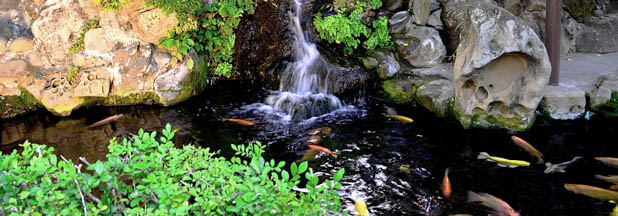Video Tutorials
Our Youtube channel has pleanty of videos to gear yourself up with the knowledge to tackle any pond feature. Feel free to browse through our categories to fulfill the answers you need answered. There are thousands of videos out there steaming on the web, but these are our top picks.
Visit our YouTube Tutorial Channel.
How to seam Pond Liner
Step #1 Layout the Liner
Layout the sections of liner to be seamed. Overlap ends 6” – 12”
Step #2 Clean the Seam Area
Lift the top liner. Use gasoline & thoroughly clean the seam area
Step #3 Mark the Seam Area
With the top liner down, use a crayon or lightly score with scissors, the seam area on the bottom liner. Raise the top liner in preparation for priming.
Step #4 Prime the Seam Area
Prime both liners. On the bottom liner, prime an area ¼” above the mark, approximately 6” – 8” wide. Prime a matching area on the top liner.
Step #5 Apply 3” Double Stick
Apply 3” double sided tape to the bottom liner, pressure rolling as you go to eliminate air bubbles or wrinkles.
Step #6 Smooth the Seam
With the double stick paper still on, replace the top liner and pressure roll the seam.
Step #7 Seal the Seam
Slit the double stick tape in the center. Overlap the liners & carefully remove the paper, pulling off the tape from between the liners at a 45º angle, one side at a time.
Step #8 Apply 6” Single Stick
Prime an area 6” wide spaced evenly over the exposed edge of the seam. Apply 6” tape over primer.
Step #9 Roll and Seal Forever
Thoroughly pressure roll the 6” tape and generously apply lap sealant along both edges of the 6” tape.
Step #10 Allow the Seam to Dry
Allow the seam to dry thoroughly before contact with water.
How to penetrate Pond Liner for pipes
Step #1 Locate
Determine the ideal location to penetrate the liner. Avoid areas near rocks or other in-water features. Penetration should be at least 6” away from pumps or filters.
Step #2 Mark
Mark the area where the hole will be cut by placing the hose against the liner. Trace the outline of the hose with a crayon or score lightly with scissors. Important – the hole size must be two thirds of the size of the pipe. A larger hole risks leaking; a small hole may cause the liner to rip when the pipe is inserted.
Step #3 Cut
Make a clean, even cut in the liner. It is very important that the cut is even and smooth – a rough cut could result in the liner splitting at the cut.
Step #4 Insert
Working from the ground side – outside the pond – carefully insert the pipe through the hole. Move the needed length of pipe through the hole at a 90º angle to the liner.
Step #5 Clean & Prime
Clean the liner and pipe adjacent to the hole with gasoline. Prime the joint area thoroughly.
Step #6 Cut & Install a Collar
Cut a strip 1” wide, long enough to wrap the liner and pipe at the penetration, from 6” sealing tape. Wrap this “collar” around the joint, half on the liner and half on the pipe, smooth out any air bubbles, and secure with a hose clamp.
Step #7 Cut & Install a Guard
Cut a second strip 2”, long enough cover the hose clamp, from 6” sealing tape. Wrap the tape around the hose clamp. This creates a “guard” over the hose clamp to prevent harming fish and to keep water out of the clamp.
Step #8 Prime and Seal
Prime an area 6” wide, centered on the hose clamp, to the pipe and liner. Apply lap sealant.
Step #9 Backfill Around the Pipe
Completely backfill and tamp down the earth in the area where the pipe penetrates the liner. Any voids in the earth will cause the liner to stretch and risks leaking.
Step #10 Allow Joint to Dry
Allow joint to dry thoroughly before contact with water.
Leak Finding Guide
The first step to finding a leak in your pond is to turn off your pump and mark the water level with a piece of tape. If you see that the water level has not fallen, then there is a leak in the plumbing or filter system (maybe by the pressure filter, waterfall, or skimmer where the liner is attached). If the water level continues to fall, then the leak is in the pond itself. You can turn the pump back on and continue to mark the water level periodically until the water stops falling. This will determine at what level the leak is at. Once this is determined, you can take a turkey baster and fill it with milk. Thicker milk like 2% or whole milk is going to be the best milk to use. Slowly go around the edge of the pond, trying not to disturb the water as much as possible while squeezing a little milk out into the area that you want to begin searching for the leak. We suggest starting on the right-hand side of the skimmer and work your way around to the other side of the pond until you have made a complete circle. While squeezing out the milk, watch and see if it moves in a certain direction. If there is a leak near you, the milk will be pulled towards the hole. If you do not see any movement, simply move over a foot and repeat the process. After discovering where the hole is located, send us pictures. Good luck!
|


